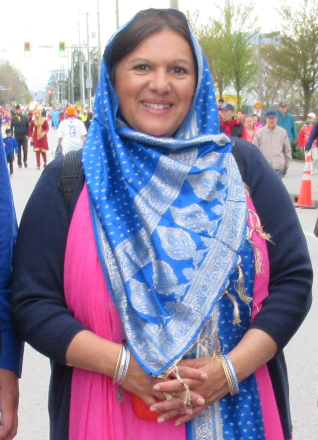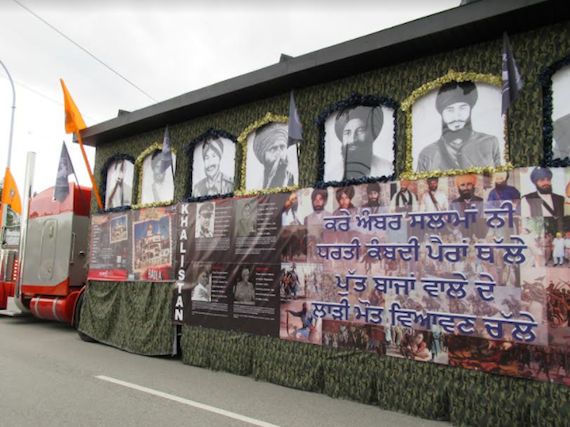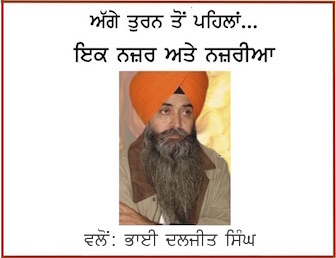Articles/Opinion » Over Seas » Sikh News
Khalsa Day Parade in Surrey was a Resounding Success, but also, with the Imperative to Remember 1984
April 30, 2017 | By INDIRA PRAHST
BY: INDIRA PRAHST*

Indira Prasht
MORE than 400,000 people flocked to last Saturday’s Khalsa Day Parade in Surrey organized by the Gurdwara Sahib Dasmesh Darbar – the largest Vaisakhi parade outside of India.
The gray skies and rain did not water down the robust celebrations; in fact, the rain brought people together in different ways when crowds huddled under tents while sipping chai and eating fresh pakoras. From the perspective of attendance, forging bonds with different communities and celebrating the birth of the Khalsa, it was a resounding success.
People of all cultures and religions joined in the occasion and according to President Dewinder Singh Grewal, remembering the creation of the Khalsa in 1699 is important “because it is the basis of what the Sikh faith is formed on and to also fight inequality around the world.”
This year’s procession featured 20 floats representing Sikh schools, Khalsa School, the Keertan kart, Gatka float, Shaheed Mewa Singh, other cultural associations, and humanitarian organizations. Kids Play had a very large float this year and a young volunteer wore the Kids Play mascot outfit which drew many young kids to their float. The most important float in the procession according to gurdwara spokesperson Moninder Singh, is the one that carries the Guru Granth Sahib (Sikh Holy Scripture) which was beautifully decorated and adorned with love and grace for Khalsa Day.

Hoardings displayed during Khalsa Day parade
The expression on people’s faces reflected profound joy in doing seva by giving out food that they had especially prepared for this jubilant occasion. The spirit of Vaisakhi and celebration of the birth of the Khalsa were felt throughout the day, with families enjoying the food and watching the floats or listening to speeches.
On the main stage a raft of speakers spoke on diverse topics ranging from the birth of the Khalsa to human rights issues and Khalistan.

Hoardings displayed during Khalsa Day parade
What was new this year was a newly decorated, Khalistan float, which was shaped like a military tank under the banner of a newly formed group “Sikh Liberation Front”, with historical representations of 1984, depicting pictures of Sikh martyrs as well as Khalistan flags. It drew a very large crowd, but also a lot of reflection about Sikh history and the sacrifices that were made. When I asked Amanpreet Kaur, a law student, about her views, she said: “When I see the Khalistan float with the shaheed’s pictures, my hope in this lifetime is to live up to the Sikh principles that they laid down their lives for. I want to ensure their sacrifices were worth it…. I have nothing but gratitude and humility knowing I have the blessing to walk in their footsteps.” It is refreshing to hear these words, as I nave noted over the years in my research, that their sacrifices have been forgotten and slowly being pushed into oblivion. Several Khalistani’s who were on the front line, told me how painful it is for them to remember the blood that was shed, the torture, families that were torn a part, living in exile and above all, how the world continues to view their acts of duty in protecting the Panth, in stigmatizing ways as ‘fanatical” or “irrational.” Moninder Singh, one of the founders of the Sikh Liberation Front, said: “Sikh history as it is represented here, comes from a Sikh perspective. With this float and actions of the organization, a narrative from Guru Granth Sahib and to freely express the revolution of Sikhi is being pushed forward.”
At this year’s event, Sikh history was at the forefront including the newly erected Operation Blue Star tent, next to Gurdwara Sahib Dasmesh Darbar. Here the trajectory of systematic and preplanned, state violence that occurred towards Sikhs, was clearly laid out and supported with facts for the world to see. I noticed that there were several students of non-Sikh background that were engaged with the photos and captions. One woman told me she knew a bit about Sikh history, but not the gravity of what unfolded in 1984. While some stake holders, prefer that the Khalsa day parade remains free of the political, there was a strong resistance against this idea by some Sikhs, as the Khalsa and the Political cannot be separated, they say. Several Sikh youth and elders told me that the floats at the Khalsa Day Parade and tents, raise awareness about Punjab, because it is where Sikhism originated. Satinderpal Singh Gill, a former senior leader of the International Sikh Youth Federation and a senior member of the gurdwara, said to me: “If we take out the pictures, Sikhs may forget about 1984, but when we see the pictures they may learn about why Sikhs sacrificed their lives, it is an important reminder of Sikh history.” Indeed, from an academic point of view which I have written about in the past, the inclusion of these images can be understood as an act of resistance against the states strategy to control cultural memory of Sikh historical atrocities which is intricately connected to Sikh identity and Sikhs having been treated as subjects outside the “Indian Nation.”
In closing, many people at the Khalsa Day parade felt it was a great event, and both the past president, Gian Singh Gill, and the current president noted that they were content to see such large numbers from diverse faiths celebrate and remember the birth of the Sikh faith which Guru Nanak Ji started and the creation of the Khalsa Panth by Guru Gobind Singh Ji.
I remember Gurdwara President Grewal’s words last year to me that the Khalsa Day “is a very special day for us at the gurdwara where we have more than 150 people that get baptized on that day.” This year, among those taking Amrit was Satinderpal Singh Gill’s young grandson. Gill said: “I am happy with my achievement. My eight-year-old grandson asked, ‘Can I have Amrit?’” He did on the morning of the Khalsa Parade. Gill said that he hopes more Sikh youth will become Amritdhari, follow the Panth and remain brave. He added: “Guru Gobind Singh Ji, when he created the Khalsa, he did so also for brave people who believed in one God, never feared death and would always be willing to fight for rights.” Indeed, the imperative to remember 1984, the sacrifices that were laid out to protect the Panth and the spirit of Khalistan were alive not only in the hearts of Sikhs, but channelled in new modes of resistance to keep the flame for the movement of Khalistan- burning bright.
* Indira Prasht is a British Columbia (Canada) based Sociologist.
To Get Sikh Siyasat News Alerts via WhatsApp:
(1) Save Our WhatsApp Number 0091-855-606-7689 to your phone contacts; and
(2) Send us Your Name via WhatsApp. Click Here to Send WhatsApp Message Now.
Sikh Siyasat is on Telegram Now. Subscribe to our Telegram Channel
Related Topics: Dashmesh Darbar, Khalsa Day Parade Surrey, Sikh Diaspora, Sikh News Canada, Sikhs in Canada




